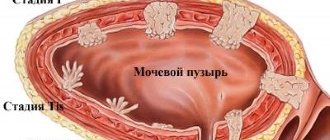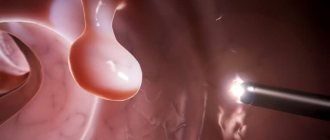There are contraindications. Specialist consultation is required.
Symptoms Indications for surgery Types of surgical interventions
Spleen cysts are a group of diseases of different origins. They are united by a common feature - the presence in the organ of a cavity (or cavities) filled with liquid and separated from the surrounding tissues by a capsule. Neoplasms can be true (dermoid, simple solitary, retention, multilocular cystadenomas), false (inflammatory, traumatic origin), and also affecting the ligaments of the spleen.
Cysts: types, diagnosis, surgical removal
Spread of the disease.
Spleen cysts are observed in 0.5 - 1% of the population. Moreover, in half of the patients, cysts are detected by chance, during a routine examination. In women, splenic cysts are 3–5 times more common than in men, and are detected mainly between 35 and 55 years. Similar to liver cysts, spleen cysts can be single, multiple, true or false.
Puchkov K.V., Ivanov V.V., Poddubny I.V., Tolstov K.N. Laparoscopic splenectomy: surgical tactics and technical aspects: monograph. - M.: ID MEDPRACTIKA - M. - 2007. - 88 p.
Prices
Price (RUB)In installments* (RUB)Consultation with a surgeon on the operation (SPECIAL)0—Online doctor’s opinion on the operation (SPECIAL)0—Laparoscopic splenectomy Cat. I. complexityfrom 49000from 4897Laparoscopic splenectomy category II. complexityfrom 69000from 6895* You can read more about the conditions here - Treatment on credit or in installments
The cost is preliminary. The exact cost of the operation can only be determined by a surgeon during a free consultation.
Causes of development of splenic cysts.
True cysts are congenital and arise as a result of impaired embryogenesis. They are diseases with autosomal dominant heredity (in the case of single splenic cysts) or may represent a single genetic defect - multiple cystic lesions of various organs, including the spleen, kidneys, liver, brain.
False cysts develop in the presence of a pathological, genetically determined reaction of splenic tissue to inflammation as a result of trauma with central or subcapsular rupture of the spleen, surgery or other factors, for example, a number of medications, infectious diseases and, as a result, a previous splenic infarction. The wall of false cysts consists of fibrous tissue of the spleen. False splenic cysts can also form after treatment of a splenic abscess, as well as after surgery to remove parasitic spleen cysts.
In what cases will a surgeon help?
Of course, surgery must be done urgently in case of cyst rupture, suppuration or bleeding. If the formation provokes constant pain and other characteristic symptoms, this is also a reason to seriously think about solving the problem surgically.
If there is a large cyst that does not cause much discomfort, surgical intervention may also be necessary. A doctor will help you weigh the potential benefits and risks, a visit to whom you definitely shouldn’t put off, even if the symptoms seem minor.
Symptoms and clinical picture of spleen cysts.
The clinical picture of a splenic cyst depends on the size, nature and location of the cyst. Small cysts up to 2 cm in diameter are asymptomatic. Patients with a splenic cyst do not present any specific complaints. With larger cysts, the patient’s general condition may remain undisturbed for a long time, but more often there is dull, localized, constant or paroxysmal pain in the abdomen, which begins in the left hypochondrium long (weeks, months and even years) before the clinical detection of the cyst.
Often with a splenic cyst, pain radiates to the left shoulder. Sometimes patients complain of a feeling of heaviness, an unpleasant sensation or bloating in the left hypochondrium after eating, and vomiting. In some cases, symptoms from the respiratory system are observed - a tingling sensation in the chest when taking a deep breath, cough, shortness of breath. With significant cyst sizes, when a single cyst reaches a diameter of 7–8 cm, or multiple cysts affect at least 20% of the volume of the spleen, an enlargement of the spleen is observed, nausea, belching appears, and the function of the abdominal organs (usually the stomach) is impaired. In the case of the development of an inflammatory process in the cyst, when the contents of the cyst suppurate, patients, in addition to pain, experience high body temperature, chills, and general weakness.
For a free written consultation, in order to determine the type of splenic cyst, its localization to the main structures of the organ and indications for surgery, as well as choosing the correct surgical treatment tactics, you can send me a full description of abdominal ultrasound, MSCT data [email protected] spleen with contrast, indicate age and main complaints. Then I will be able to give a more accurate answer to your situation.
The main complications of non-parasitic splenic cyst include:
- rupture of a splenic cyst with leakage of the cyst contents into the abdominal cavity, resulting in the development of an “acute abdomen”, severe intoxication and peritonitis;
- bleeding into the cyst cavity followed by its rupture and open profuse bleeding into the abdominal cavity;
- suppuration of the cyst in case of infection, with the development of general severe intoxication of the body.
Odrex Patient History
“I work as a mechanic in the merchant navy. Minor injuries and bruises are commonplace on a boat, so when I fell on my stomach and hit my chest, I didn’t think anything of it. Moreover, at that moment nothing bothered me.
I saw a doctor on land, about a year after that fall. From time to time I felt pain and discomfort in my left side, and the time was approaching for a scheduled examination before leaving for the next flight. Through insurance, I turned to Odrex to the surgeon Anastasia Sergeeva . She inspired my confidence, and I decided to have the operation.
I was surprised how quickly I got back on my feet. Almost immediately I was able to continue living a full life. I am grateful to Anastasia for her professionalism and responsiveness,” Oleg Strekul , patient.
Diagnosis of splenic cyst.
Splenic cysts are detected in most cases during a clinical examination and routine examination, as well as during a diagnostic search for gastrointestinal diseases during ultrasound examination and computed tomography with bolus contrast.
In the diagnostic algorithm for identifying single splenic cysts, the key issue is to determine the non-parasitic nature of the detected cysts. To resolve this issue, it is necessary to conduct serological studies with parasitic diagnostics for the presence of echinococcosis (Cazzoni reaction and hemagglutination) and alveococcosis (latex agglutination reaction).
Our doctors
Gordeev Sergey Alexandrovich
Surgeon, Candidate of Medical Sciences, doctor of the highest category
42 years of experience
Make an appointment
Lutsevich Oleg Emmanuilovich
Chief Surgeon of CELT, Honored Doctor of the Russian Federation, Chief Specialist of the Moscow Department of Health in Endosurgery and Endoscopy, Corresponding Member of the Russian Academy of Sciences, Head of the Department of Faculty Surgery No. 1 of the State Budgetary Educational Institution BPO MGMSU, Doctor of Medical Sciences, Doctor of the Highest Category, Professor
43 years of experience
Make an appointment
Prokhorov Yuri Anatolievich
Surgeon, head of the surgical service of CELT, candidate of medical sciences, doctor of the highest category
33 years of experience
Make an appointment
Fedorova Elena Vladimirovna
Surgeon, Candidate of Medical Sciences, doctor of the highest category
22 years of experience
Make an appointment
Treatment of spleen cysts.
For uncomplicated non-parasitic splenic cysts with a diameter of up to 3 cm, it is necessary to actively monitor patients, conducting control ultrasound examinations 1–2 times a year. If the size of the cyst increases or its structure changes, it is necessary to perform a computed tomography scan of the abdominal organs with contrast (to exclude malignant growth in the cyst wall). Surgery is not indicated for such patients.
Traditional methods of treatment for ultrasound-proven splenic cysts are ineffective, since there are no mechanisms for resorption of focal fibrosis, which normally develops around the cyst as a protective reaction of the body to inflammation caused by the cyst.
Indications for surgical treatment of splenic cysts include 3 groups of pathological conditions:
- absolute indications for surgery - suppuration, rupture, bleeding;
- conditional - absolute - suppuration, rupture, bleeding
- giant cyst of any location (more than 10 cm in diameter);
- a cyst with a pronounced clinical picture (constant pain in the hypochondrium, dyspeptic symptoms, etc.);
- relative
- large cysts (from 3 to 10 cm in diameter);
- recurrent splenic cysts in case of ineffectiveness of previous treatment methods.
Surgical treatment today is the best option to eliminate the cause of the disease and return the patient to normal activities.
The main types of surgical operations for the treatment of splenic cysts include:
- removal of most of the cyst with its membranes and treatment of the internal lining with argon-enhanced plasma;
- resection of the affected part of the organ with a cyst;
- removal of the spleen along with the affected areas of the organ and cyst (splenectomy) and autotransplantation of splenic tissue into the greater omentum;
- puncture of the cyst under ultrasound control and injection of a sclerosing solution into the cavity.
Watch a video of operations for a splenic cyst performed by Professor K.V. Puchkov. You can visit the website “Video of operations of the best surgeons in the world.”
Puncture of splenic cysts is currently a possible option in the treatment of simple single (solitary) uncomplicated cysts with a diameter of up to 3–5 cm and located subcapsularly along the diaphragmatic surface of the organ. Currently, percutaneous therapeutic and diagnostic puncture of a cyst is carried out only with sclerosing, since puncture of a kidney cyst without the use of a sclerosing agent in most cases leads to recurrence of the cyst and the need for repeated intervention. In some cases, there may even be an increase in the volume of the cyst compared to its original size. Percutaneous therapeutic and diagnostic puncture of a splenic cyst is carried out under ultrasound control, then the contents are evacuated and an adhesive substance is introduced into its cavity.
Resection or splenectomy, if technically possible and the surgeon is properly qualified, should be performed using a laparoscopic approach. Traditional open operations with large incisions of the abdominal wall from the xiphoid process to the navel are performed to a limited extent in modern conditions.
Rice. 1. Type of laparoscopic operating room - the operation is performed through small punctures in the abdominal wall (photo and diagram of the location of the operating team).
Laparoscopic surgical interventions on the spleen are classified as complex and high-tech operations. The surgeon must have extensive experience in performing open operations and appropriate special equipment to perform laparoscopic interventions on the spleen.
In this case, excision of the walls of the cysts must be carried out within healthy tissues without resection of the spleen, which makes it possible to practically not disrupt its function as an organ. During the operation, it is advisable to use ultrasonic surgical scissors and a device for dosed electrothermal tissue ligation “Liga sure” (USA), which allow these operations to be performed bloodlessly. For single cysts larger than 5 cm, which are located close to the surface of the spleen (subcapsular), it is necessary to excise the “roof” of the cyst, and treat the inside with argon-enhanced plasma (Force Triad, USA) to prevent relapse. In case of vessels close to the cyst wall, I use modern hemostatic agents - PerClot (Italy).
In this case, all removed cyst walls must be sent for histological examination.
If for a number of reasons (large size of the cyst, its location in the hilum of the spleen, etc.) it is impossible to save the organ and it is necessary to perform a splenectomy, then in this case most foreign colleagues strongly recommend laparoscopic autotransplantation of the patient’s own splenic tissue into the greater omentum, which allows you to preserve the immunological properties of the organ.
Laparoscopic access in the treatment of splenic cysts has a number of undoubted advantages - minimal trauma, excellent cosmetic effect, rapid recovery, and the possibility of simultaneous correction of concomitant diseases of the abdominal and pelvic organs that require surgical treatment.
In the future, the patient is recommended to be monitored by a surgeon and hematologist. Patients who have undergone surgery for a splenic cyst do not need a special diet. It is advisable to limit vigorous physical activity for 2–3 months. After the end of the rehabilitation period, the person is considered healthy, but it is advisable to carry out ultrasound monitoring every 6 months during the first two years after surgery.
— Such high-tech operations probably require special equipment?
Yes, such operations require unique and expensive equipment. Not all hospitals have such modern equipment. The Morozov Children's City Clinical Hospital has all the necessary equipment in full. For example, an argon plasma coagulator. We have two of them - from Söring and Bowa.
An argon plasma coagulator allows you to burn out the internal lining of the cyst and control hemostasis (the body system whose function is to keep blood in a liquid state and stop bleeding). This is very important during operations on the spleen, since it is a blood-forming organ and is supplied with blood very well. When partial resection of the spleen is performed, it is important to achieve 100% hemostasis so that there are no complications, and there have never been complications.
On average, we operate on 20–25 children with true splenic cysts per year. By the way, malignant neoplasms are very rare; in my practice it happened a maximum of 3 times.









